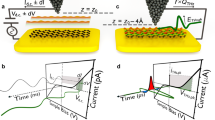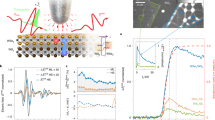Abstract
Ultrafast control of current on the atomic scale is essential for future innovations in nanoelectronics. Extremely localized transient electric fields on the nanoscale can be achieved by coupling picosecond duration terahertz pulses to metallic nanostructures. Here, we demonstrate terahertz scanning tunnelling microscopy (THz-STM) in ultrahigh vacuum as a new platform for exploring ultrafast non-equilibrium tunnelling dynamics with atomic precision. Extreme terahertz-pulse-driven tunnel currents up to 107 times larger than steady-state currents in conventional STM are used to image individual atoms on a silicon surface with 0.3 nm spatial resolution. At terahertz frequencies, the metallic-like Si(111)-(7 × 7) surface is unable to screen the electric field from the bulk, resulting in a terahertz tunnel conductance that is fundamentally different than that of the steady state. Ultrafast terahertz-induced band bending and non-equilibrium charging of surface states opens new conduction pathways to the bulk, enabling extreme transient tunnel currents to flow between the tip and sample.
This is a preview of subscription content, access via your institution
Access options
Access Nature and 54 other Nature Portfolio journals
Get Nature+, our best-value online-access subscription
$29.99 / 30 days
cancel any time
Subscribe to this journal
Receive 12 print issues and online access
$209.00 per year
only $17.42 per issue
Buy this article
- Purchase on Springer Link
- Instant access to full article PDF
Prices may be subject to local taxes which are calculated during checkout






Similar content being viewed by others
References
Völcker, M., Krieger, W. & Walther, H. Laser-driven scanning tunneling microscope. Phys. Rev. Lett. 66, 1717–1720 (1991).
Lee, J., Long, C. J., Yang, H., Xiang, X.-D. & Takeuchi, I. Atomic resolution imaging at 2.5 GHz using near-field microwave microscopy. Appl. Phys. Lett. 97, 183111 (2010).
Cocker, T. L. et al. An ultrafast terahertz scanning tunnelling microscope. Nat. Photon. 7, 620–625 (2013).
Cocker, T. L., Peller, D., Yu, P., Repp, J. & Huber, R. Tracking the ultrafast motion of a single molecule by femtosecond orbital imaging. Nature 539, 263–267 (2016).
Yoshioka, K. et al. Real-space coherent manipulation of electrons in a single tunnel junction by single-cycle terahertz electric fields. Nat. Photon. 10, 762–765 (2016).
Khusnatdinov, N. N., Nagle, T. J. & Nunes, G. Jr Ultrafast scanning tunneling microscopy with 1 nm resolution. Appl. Phys. Lett. 77, 4434–4436 (2000).
Grafström, S. Photoassisted scanning tunneling microscopy. J. Appl. Phys. 91, 1717–1753 (2002).
Loth, S., Etzkorn, M., Lutz, C. P., Eigler, D. M. & Heinrich, A. J. Measurement of fast electron spin relaxation times with atomic resolution. Science 329, 1628–1630 (2010).
Wu, S. W. & Ho, W. Two-photon-induced hot-electron transfer to a single molecule in a scanning tunneling microscope. Phys. Rev. B 82, 085444 (2010).
Saunus, C., Bindel, J. R., Pratzer, M. & Morgenstern, M. Versatile scanning tunneling microscopy with 120 ps time resolution. Appl. Phys. Lett. 102, 051601 (2013).
Yoshida, S. et al. Single-atomic-level probe of transient carrier dynamics by laser-combined scanning tunneling microscopy. Appl. Phys. Express 6, 032401 (2013).
Yoshida, S. et al. Probing ultrafast spin dynamics with optical pump–probe scanning tunnelling microscopy. Nat. Nanotech. 9, 588–593 (2014).
Dey, S., Mirell, D., Rodriguez Perez, A., Lee, J. & Apkarian, V. A. Nonlinear femtosecond laser induced scanning tunneling microscopy. J. Chem. Phys. 138, 154202 (2013).
Lee, J., Perdue, S. M., Rodriguez Perez, A. & Apkarian, V. A. Vibronic motion with joint angstrom–femtosecond resolution observed through Fano progressions recorded within one molecule. ACS Nano 8, 54–63 (2014).
Rashidi, M. et al. Time-resolved single dopant charge dynamics in silicon. Nat. Commun. 7, 13258 (2016).
Kampfrath, T., Tanaka, K. & Nelson, K. A. Resonant and nonresonant control over matter and light by intense terahertz transients. Nat. Photon. 7, 680–690 (2013).
Wimmer, L. et al. Terahertz control of nanotip photoemission. Nat. Phys. 10, 432–436 (2014).
Herink, G., Wimmer, L. & Ropers, C. Field emission at terahertz frequencies: AC-tunneling and ultrafast carrier dynamics. New J. Phys. 16, 123005 (2014).
Li, S. & Jones, R. R. High-energy electron emission from metallic nano-tips driven by intense single-cycle terahertz pulses. Nat. Commun. 7, 13405 (2016).
Iwaszczuk, K., Zalkovskij, M., Strikwerda, A. C. & Jepsen, P. U. Nitrogen plasma formation through terahertz-induced ultrafast electron field emission. Optica 2, 116–123 (2015).
Mittleman, D. M. Frontiers in terahertz sources and plasmonics. Nat. Photon. 7, 666–669 (2013).
Huber, A. J., Keilmann, F., Wittborn, J., Aizpurua, J. & Hillenbrand, R. Terahertz near-field nanoscopy of mobile carriers in single semiconductor nanodevices. Nano Lett. 8, 3766–3770 (2008).
Eisele, M. et al. Ultrafast multi-terahertz nano-spectroscopy with sub-cycle temporal resolution. Nat. Photon. 8, 841–845 (2014).
Chen, C. J. Introduction to Scanning Tunneling Microscopy 2nd edn (Oxford Univ. Press, 2008).
Voigtländer, B. Scanning Probe Microscopy (Springer, 2015).
Chen, C. J. Microscopic view of scanning tunneling microscopy. J. Vac. Sci. Technol. A 9, 44–50 (1990).
Hamers, R. J., Tromp, R. M. & Demuth, J. E. Surface electronic structure of Si(111)-(7 × 7) resolved in real space. Phys. Rev. Lett. 56, 1972–1975 (1986).
Krause, S., Berbil-Bautista, L., Herzog, G., Bode, M. & Wiesendanger, R. Current-induced magnetization switching with a spin-polarized scanning tunneling microscope. Science 317, 1537–1540 (2007).
Hasunuma, R., Komeda, T., Mukaida, H. & Tokumoto, H. Atom manipulation on Si(111)-7 × 7 surface by contact formation of biased scanning tunneling microscope tip: surface structures and tip current variation with atom removal. J. Vac. Sci. Technol. A 15, 1482–1487 (1997).
Mysliveček, J. et al. Structure of the adatom electron band of the Si(111)-7 × 7 surface. Phys. Rev. B 73, 161302 (2006).
Modesti, S., Gutzmann, H., Wiebe, J. & Wiesendanger, R. Correction of systematic errors in scanning tunneling spectra on semiconductor surfaces: the energy gap of Si(111)-7 × 7 at 0.3 K. Phys. Rev. B 80, 125326 (2009).
Liao, Y. C. et al. Evolution of surface to bulk tunneling spectrum by scanning tunneling microscopy. Phys. Rev. B 81, 195435 (2010).
Feenstra, R. M., Gaan, S., Meyer, G. & Rieder, K. H. Low-temperature tunneling spectroscopy of Ge(111)c(2 × 8) surfaces. Phys. Rev. B 71, 125316 (2005).
Wutscher, T., Weymouth, A. J. & Giessibl, F. J. Localization of the phantom force induced by the tunneling current. Phys. Rev. B 85, 195426 (2012).
Taucer, M. et al. Single-electron dynamics of an atomic silicon quantum dot on the H-Si(100)-(2 × 1) surface. Phys. Rev. Lett. 112, 256801 (2014).
Martins, B. V. C., Smeu, M., Livadaru, L., Guo, H. & Wolkow, R. A. Conductivity of Si(111)-(7 × 7): the role of a single atomic step. Phys. Rev. Lett. 112, 246802 (2014).
Just, S. et al. Surface and step conductivities on Si(111) surfaces. Phys. Rev. Lett. 115, 066801 (2015).
Lock, D., Rusimova, K. R., Pan, T. L., Palmer, R. E. & Sloan, P. A. Atomically resolved real-space imaging of hot electron dynamics. Nat. Commun. 6, 8365 (2015).
Odobescu, A. B., Maizlakh, A. A. & Zaitsev-Zotov, S. V. Electron correlation effects in transport and tunneling spectroscopy of the Si(111)-7 × 7 surface. Phys. Rev. B 92, 165313 (2015).
Ortega, J., Flores, F. & Levy Yeyati, A. Electron correlation effects in the Si(111)-7 × 7 surface. Phys. Rev. B 58, 4584–4588 (1998).
Losio, R., Altmann, K. N. & Himpsel, F. J. Fermi surface of Si(111)7 × 7. Phys. Rev. B 61, 10845–10853 (2000).
Tanikawa, T., Yoo, K., Matsuda, I., Hasegawa, S. & Hasegawa, Y. Nonmetallic transport property of the Si(111)7 × 7 surface. Phys. Rev. B 68, 113303 (2003).
Barke, I., Zheng, F., Konicek, A. R., Hatch, R. C. & Himpsel, F. J. Electron-phonon interaction at the Si(111)-7 × 7 surface. Phys. Rev. Lett. 96, 216801 (2006).
Mauerer, M., Shumay, I. L., Berthold, W. & Höfer, U. Ultrafast carrier dynamics in Si(111)7 × 7 dangling bonds probed by time-resolved second-harmonic generation and two-photon photoemission. Phys. Rev. B 73, 245305 (2006).
Wells, J. W., Kallehauge, J. F., Hansen, T. M. & Hofmann, P. Disentangling surface, bulk, and space-charge-layer conductivity in Si(111)-(7 × 7). Phys. Rev. Lett. 97, 206803 (2006).
D’angelo, M. et al. Conductivity of the Si(111)7 × 7 dangling-bond state. Phys. Rev. B 79, 035318 (2009).
Nguyen, P. H. et al. Coupling terahertz pulses to a scanning tunneling microscope. Phys. Can. 71, 157–160 (2015).
Baccarani, G. & Ostoja, P. Electron mobility empirically related to the phosphorus concentration in silicon. Solid-State Electron. 18, 579–580 (1975).
Rybka, T. et al. Sub-cycle optical phase control of nanotunnelling in the single-electron regime. Nat. Photon. 10, 667–670 (2016).
Rashidi, M. et al. Time-resolved imaging of negative differential resistance on the atomic scale. Phys. Rev. Lett. 117, 276805 (2016).
Feenstra, R. M. & Stroscio, J. Tunneling spectroscopy of the GaAs(110) surface. J. Vac. Sci. Technol. B 5, 923–929 (1987).
Hamers, R. J., Tromp, R. M. & Demuth, J. E. Electronic and geometric structure of Si(111)-(7 × 7) and Si(001) surfaces. Surf. Sci. 181, 346–355 (1987).
Güntherodt, H.-J. & Wiesendanger, R. (eds) Scanning Tunneling Microscopy I (Springer, 1992).
Wiesendanger, R. Scanning Probe Microscopy and Spectroscopy: Methods and Applications (Cambridge Univ. Press, 1994).
Lee, Y.-S. Principles of Terahertz Science and Technology (Springer, 2008).
Blanchard, F., Doi, A., Tanaka, T. & Tanaka, K. Real-time, subwavelength terahertz imaging. Annu. Rev. Mater. Res. 43, 237–259 (2013).
Hecht, E. Optics 4th edn (Addison Wesley, 2002).
Acknowledgements
We acknowledge fruitful discussions with T. Cocker, R. Huber, C. Ropers, R. Wolkow, J. Burgess and D. Jenson. This work was supported by the Natural Sciences and Engineering Research Council of Canada (NSERC), the Canada Foundation for Innovation (CFI), the Alberta Science and Research Investments Program (ASRIP), the Alberta Innovates Technology Futures (AITF) Strategic Chairs Program, and the Informatics Circle of Research Excellence (iCORE) Centre for Interdisciplinary Nanoscience (iCiNano). V.J. acknowledges support from NSERC and AITF. K.I. acknowledges support from the Danish Council for Independent Research under Postdoc Project 64092. C.R. acknowledges support from the German Academic Exchange Service (DAAD). We thank R. Wolkow for providing the Si sample, S. Xu (Alberta Centre for Surface Engineering and Science, University of Alberta) for scanning electron microscope imaging of the tungsten tip and A. He for secondary ion mass spectrometry of the Si sample. We are grateful for technical support from G. Popowich, D. Fortin and B. Shi. Electromagnetic simulations were carried out using COMSOL Multiphysics with licence provided by CMC Microsystems.
Author information
Authors and Affiliations
Contributions
V.J. and F.A.H. conceived the UHV THz-STM experiment, interpreted the data and designed the set-up. V.J. and J.R.H. built the set-up. V.J. carried out experiments, analysed the data and wrote the manuscript. V.J. and K.I. developed the Bardeen tunnelling model, hot electron model and fits to the data. P.H.N., C.R. and G.J.H. performed the electromagnetic simulations. P.H.N., G.J.H., H.M.S. and J.R.H. contributed to preliminary measurements with the UHV THz-STM system. M.R.F. contributed to interpretation of the data. F.A.H. initiated and supervised the project. All authors contributed to discussions.
Corresponding authors
Ethics declarations
Competing interests
The authors declare no competing financial interests.
Supplementary information
Supplementary information
Supplementary information (PDF 2420 kb)
Rights and permissions
About this article
Cite this article
Jelic, V., Iwaszczuk, K., Nguyen, P. et al. Ultrafast terahertz control of extreme tunnel currents through single atoms on a silicon surface. Nature Phys 13, 591–598 (2017). https://doi.org/10.1038/nphys4047
Received:
Accepted:
Published:
Issue Date:
DOI: https://doi.org/10.1038/nphys4047
This article is cited by
-
Ultrafast atomic-scale scanning tunnelling spectroscopy of a single vacancy in a monolayer crystal
Nature Photonics (2024)
-
Terahertz near-field microscopy based on an air-plasma dynamic aperture
Light: Science & Applications (2022)
-
Real-space subfemtosecond imaging of quantum electronic coherences in molecules
Nature Photonics (2022)
-
Autonomous scanning probe microscopy investigations over WS2 and Au{111}
npj Computational Materials (2022)
-
Spintronic terahertz emission with manipulated polarization (STEMP)
Frontiers of Optoelectronics (2022)



